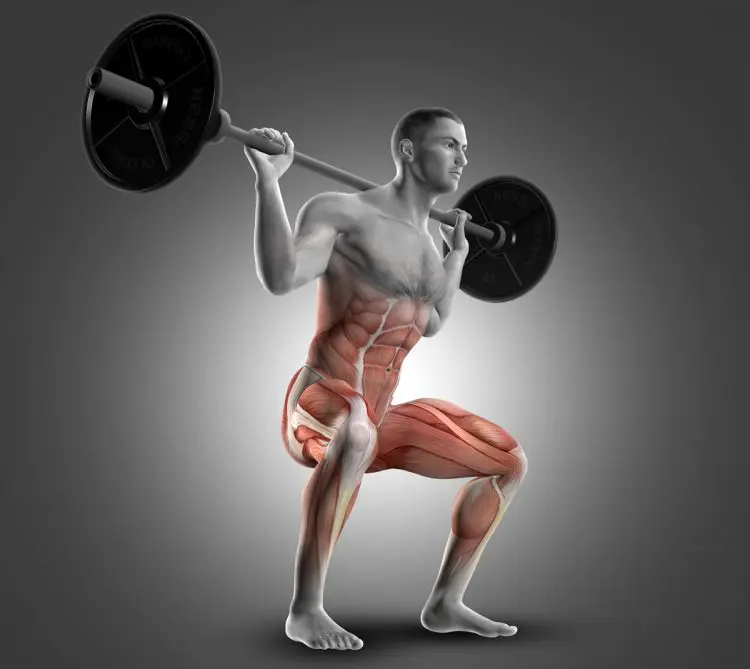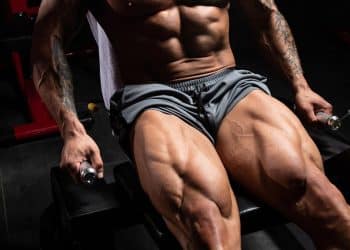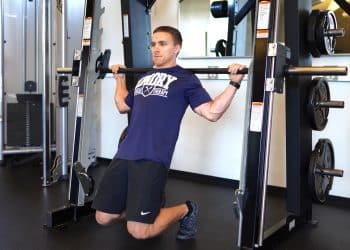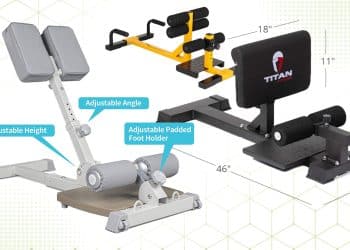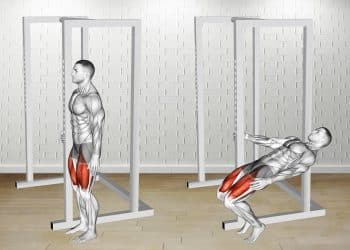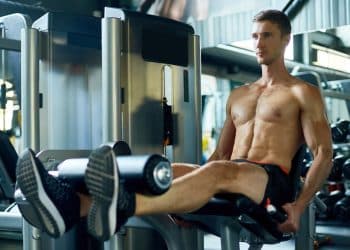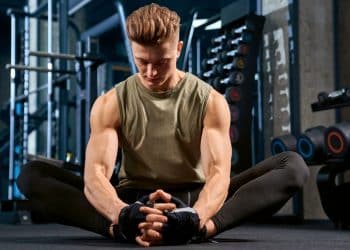When it comes to building muscle, getting strong, or training for sport, squats are often considered all but compulsory. After all, squats are even known as the king of exercises, which is a title they probably deserve.
But, while most people agree that squats are an essential and effective exercise, squat depth is often up for debate. Powerlifters tend to favor squats to parallel, as that’s what they do in competition. That said, Olympic lifters often descend far below this point, as that’s what’s required in their sport.
CrossFit and functional trainers have also championed the ATG Squat. Do deep, or go home, right?!
So, for some exercisers, the only acceptable squat depth is Ass to Grass or ATG for short. This Means descending until your hamstrings come into contact with your calves and is basically as deep as you can go.
While not everyone is built to do ATG squats, it’s a legitimate exercise that could well deserve a place in your workouts.
Level Up Your Fitness: Join our 💪 strong community in Fitness Volt Newsletter. Get daily inspiration, expert-backed workouts, nutrition tips, the latest in strength sports, and the support you need to reach your goals. Subscribe for free!
In this article, we discuss how and why to do ATG squats and provide you with some similarly effective variations and alternatives.
ATG Squat – Muscles Worked
ATG squats are a compound exercise, meaning they involve multiple muscle groups and more than two joints working together. The primary muscles affected by ATG squats are:
Quadriceps – located on the front of your thighs, the quadriceps do a lot of the work during ATG squats. There are four quad muscles: the rectus femoris, vastus lateralis, vastus intermedius, and vastus medialis. The quadriceps extend your knees and flex your hips.
Hamstrings – the three hamstring muscles are the biceps femoris, semimembranosus, and semitendinosus. Located on the back of your thighs, the hamstrings extend your hips and flex your knees.
Gluteus maximus – the glutes are the large muscle on the back of your hip. They’re mainly responsible for hip joint extension. The glutes are basically your butt and are the biggest muscle in the human body.
Abductors – located on the outside of your hips and thighs, the abductors are responsible for drawing your leg out and away from the midline of your body. During ATG squats, they stop your knees from rolling inward. The abductors are gluteus medius, gluteus minimus, and tensor fascia latae.
Adductors – the adductors draw your thigh in toward the midline of your body. During ATG squats, they prevent your knees from rolling outward. Located on the inside of your thighs, the three adductor muscles are the longus, brevis, and magnus.
Core – squatting with a weight on your shoulders requires good core stability, with core being the collective term for the muscles of your midsection. The core muscles are rectus abdominus, obliques, transverse abdominus, and erector spinae. These muscles contract inward to create intra-abdominal pressure when you brace. Bracing helps support your lumbar spine from within, minimizing unwanted movement of your lower back.
How to Do ATG Squats
Get more from ATG squats while keeping your risk of injury to a minimum by following these guidelines:
- Stand with your feet about shoulder-width apart, toes turned slightly outward.
- Rest and hold a barbell across your upper back. It should sit on your upper traps and not your neck. Hold the bar with a slightly wider than shoulder-width grip.
- You can also do ATG squats without weights.
- Pull your shoulders down and back, brace your core, and lift your chest.
- Bend your knees and let them drift forward as you squat down as far as you can. Push your knees outward to create space for your hips. Keep your torso as upright as possible, and do not allow your lower back to round.
- Drive your feet into the floor, extend your legs, and stand back up, taking care to ensure that your hips don’t rise faster than your shoulders.
- Reset your core and repeat.
Please note: Squat depth and your ability to do ATG squats depends on several factors, including ankle, knee, and hip mobility, your orthopedic (joint) health, your height, leg, and torso length. As such, not everyone can safely or comfortably do ATG squats.
Read more about optimal squat depth here.
ATG Squat Benefits
Not sure if ATG squats should be part of your leg workouts? Consider these benefits and then make your decision!
Increased quads activation – deep ATG squats take your quadriceps through a larger range of motion, which may help increase muscle mass and strength more than parallel squats. However, there is a trade-off because you could also find you cannot lift as much weight, which could make ATG squats less effective for some lifters.
Improved mobility – like the so-called Asian squat, ATG squats involve an extended range of motion that stretches almost every significant lower body muscle. Doing ATG squats may help improve lower body mobility. However, you’ll also need good flexibility and mobility to do them in the first place.
Standardized range of motion – if you squat ATG, each rep should hit the same depth. As such, every rep will involve lowering and lifting the weight for the same distance. In contrast, without this reference point, it’s all too easy to start squatting a little shallower as your legs begin to fatigue. ATG squats help ensure all your reps are done to a uniform depth.
Makes other types of squats feel easier – after a few months of ATG squats, almost every other type of squat will feel easier and more comfortable. Exercises like box squats, front squats, and parallel squats are considerably less demanding than ATG squats.
ATG Squat Drawbacks
While ATG squats are a mostly beneficial exercise, there are also a few drawbacks to consider:
Not everyone is built to do ATG squats – while some people have no problem squatting below parallel, others find it impossible to do safely. Poor flexibility and mobility or pre-existing orthopedic hip or knee problems could make ATG squats painful or impossible. While flexibility and mobility can often be improved, hip and knee health could worsen if you force yourself to do ATG squats.
Butt wink – some exercisers find that the bottom of their pelvis tilts under and their lower back becomes rounded during ATG squats. This is called butt wink. A rounded lower back is a weak lower back, and the stresses that should be on your core muscles end up on the disks and ligaments of your lumbar spine. Butt wink is less likely if you squat to parallel instead of ATG.
They may be unnecessary for some lifters – while ATG squats are a great exercise, for a lot of lifters, there is no real advantage to squatting below parallel. Descending to parallel provides most of the benefits of ATG squats but is a more accessible exercise. There is nothing wrong with ATG squats, but unless you need to squat deep, such as for Olympic lifting, doing so may be unnecessary.
Level Up Your Fitness: Join our 💪 strong community in Fitness Volt Newsletter. Get daily inspiration, expert-backed workouts, nutrition tips, the latest in strength sports, and the support you need to reach your goals. Subscribe for free!
7 ATG Squat Alternatives and Variations
ATG squats are a highly effective lower body exercise, but that doesn’t mean you should do them all the time. There are several variations and alternatives you can use to keep your workouts productive and interesting:
1. ATG front squat
Most people can squat deeper with front squats than back squats. Front squats make it easier to keep your torso upright, and your knees naturally move forward, so there is more knee flexion. So, if you are struggling to do ATG back squats, making the switch to front squats could be the solution you’ve been looking for.
How to do it:
- Rest and hold a barbell across the front of your shoulders with an overhand, shoulder-width grip. Push your elbows forward and under the bar so that your upper arms are parallel to the floor. The bar should rest against your neck, but it should not press on your throat.
- Brace your core and pull your shoulders down and back.
- Set your feet between hip and shoulder-width apart. Most people use a narrower stance for front squats compared to back squats.
- Simultaneously bend your knees and hips and descend as far as you can while keeping your torso upright and your elbows up. Do not allow your knees to drop out or fall in. Try to look straight ahead and not down at the floor.
- Without bouncing out of the bottom, drive your feet into the floor and stand back up. Force your elbows upward as you ascend to stop the bar rolling off your shoulders.
- Reset your core and repeat.
Learn more about front squats here.
2. Overhead squat
If you’ve got good mobility and can do ATG squats reasonably proficiently, you’re probably ready for a new challenge – overhead squats. Like ATG squats, overhead squats develop strength and mobility. Not just in your legs but in your upper body, too. It’s also a valuable exercise for increasing shoulder stability and core strength.
Start doing overhead squats with an empty barbell so that if the weight starts to drift forward or backward, you won’t lose control of it. Alternatively, use a wooden or plastic pole until you are confident you have mastered this tricky exercise.
Read more about overhead squats here.
3. ATG split squat
If ATG front or back squats are proving hard to master, try ATG split squats. They allow you to work one leg at a time and require less overall flexibility and mobility. However, they get you used to taking your knees into a deeply flexed position and are an excellent preparatory exercise for full ATG squats.
How to do it:
- Stand with your feet together, arms by your sides. Take a large step forward into a split stance and stop. This is your start/finish position.
- Bend your front leg, push your knee forward over your toes, and sink forward into a deep lunge. Try to get your hamstring to touch the back of your calf. Your rear leg should be almost straight.
- Extend your front leg and return to the starting position.
- Repeat for the desired number of reps and then change legs.
4. Heels elevated goblet squat
This exercise is an excellent solution if tight calves and immobile ankles are your ATG nemesis. Goblet squats allow you to maintain an upright torso while raising your heels helps eliminate the problems caused by calf tightness or stiff ankles. This is an excellent preparatory exercise for ATG squats.
How to do it:
- Place two bumper weight plates on the floor about hip-width apart. Alternatively, use a length of wooden plank. Stand with your heels raised and the balls of your feet on the floor.
- Hold a kettlebell or dumbbell in front of your chest and just below your chin. Pull your shoulders down and back, brace your core. Look straight ahead.
- Keeping your torso upright, bend your knees, and squat as deeply as you can without rounding your lower back.
- Stand up, stopping just short of locking your knees to keep the tension on your muscles.
- Descend again and repeat for the required number of repetitions.
Learn more about this helpful exercise here.
5. Sissy squat
Like ATG squats, sissy squats involve descending until your calves and hamstrings meet. However, with sissy squats, you get to use your arms for balance, and leaning back means hip mobility and flexibility are not really an issue.
How to do it:
- Stand next to a wall or some other object you can use for balance.
- Rise up onto your tiptoes.
- Push your hips and knees forward and squat down as you simultaneously lean back. Descend as far as you can, ideally until your shins are roughly parallel to the floor and your calves and hamstrings touch.
- Drive your toes into the floor and stand back up.
- Tense your quads at the top of each rep and repeat.
Make this exercise harder by holding a dumbbell down by your side or weight plate across your chest with the hand furthest from the wall/support.
Learn even more about sissy squats here.
6. Hack squat machine
While machine hack squats are far less functional than ATG front or back squats, they make it possible to use a similar range of motion and descend until your hamstrings touch the back of your calves. Simply move your feet back under you and push your knees forward as you start each rep. Some lifters will also welcome the added back support that hack squats provide.
Read more about this popular leg exercise here.
7. Short-step lunges
Lunges are excellent unilateral leg exercise, which means they work one side at a time. Taking a shorter-than-normal step increases the range of motion at your front knee, which leads to greater quads activation. As such, it’s a decent alternative to ATG squats and considerably easier to master.
How to do it:
- Stand with your feet together and your arms by your sides. Hold dumbbells if you wish.
- Take a small step forward, bend your legs, and lower your rearmost knee down to just behind your front heel.
- Step up and forward into another rep.
- Continue alternating legs for the specified number of reps.
ATG Squats – Wrapping Up
Forget the memes; you don’t HAVE to do ATG squats. For some lifters, squatting to parallel is plenty deep enough, and descending lower could result in acute or chronic knee and lower back injuries.
A parallel squat with perfect form will always be better than an ATG squat with poor form!
That said, if you can do ATG squats, it’s good to know that they’re a great strength and muscle builder, as well as being good for lower body mobility and flexibility.
If you want to try ATG squats, start light and increase your range of motion as you get used to the extra movement. Only add weight when you are confident you can go ATG without rounding your lower back or compromising your knee health.
Don’t like ATG squats or can’t make it down much below parallel? No problem! Use any of the alternatives listed above to work your legs in much the same way.
Interested in measuring your progress? Check out our strength standards for Overhead Squat, Box Squat, Goblet Squat, and more.


